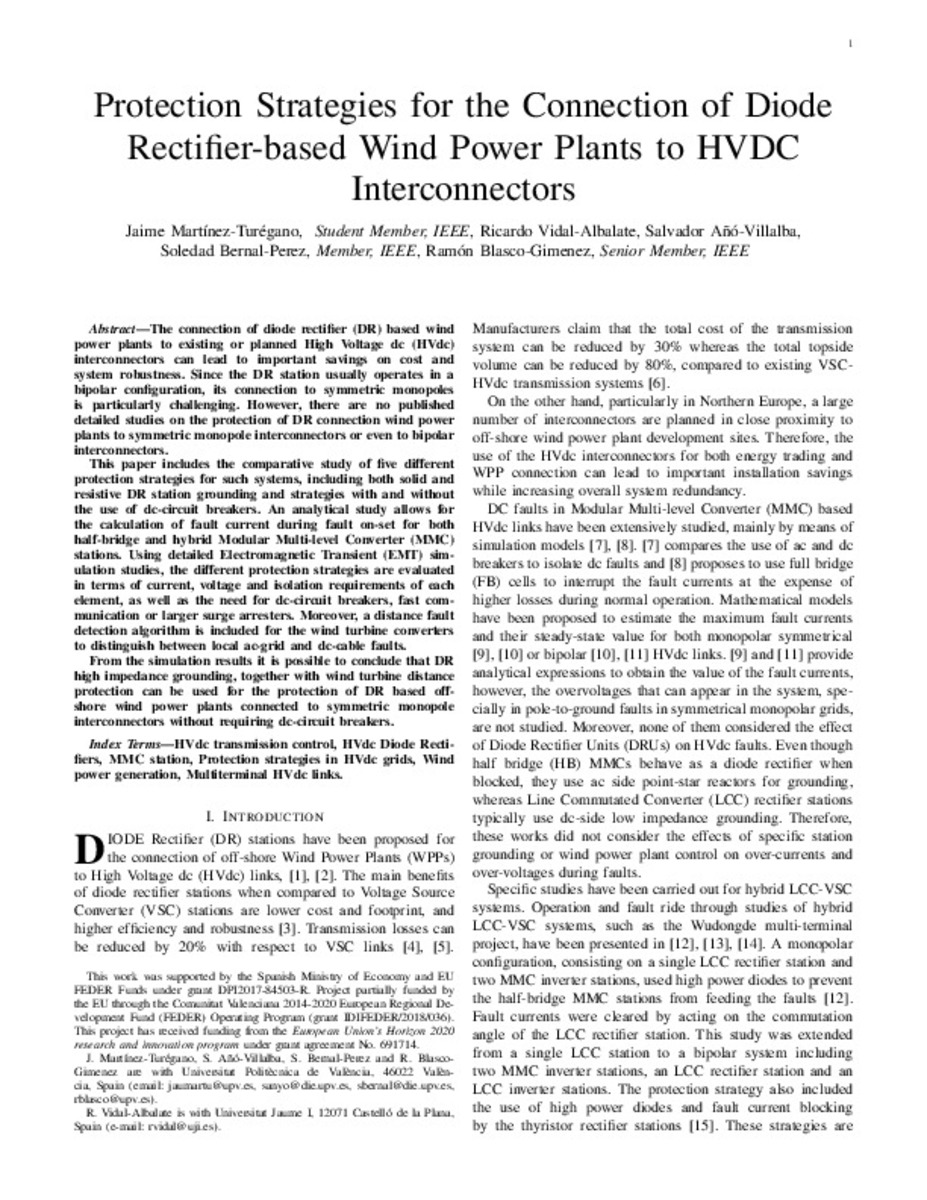| dc.contributor.author | Martínez-Turégano, J. | |
| dc.contributor.author | Vidal-Albalate, Ricardo | |
| dc.contributor.author | Añó-Villalba, Salvador | |
| dc.contributor.author | Bernal-Perez, Soledad | |
| dc.contributor.author | Blasco-Gimenez, Ramon | |
| dc.date.accessioned | 2022-02-10T11:10:23Z | |
| dc.date.available | 2022-02-10T11:10:23Z | |
| dc.date.issued | 2020-10-05 | |
| dc.identifier.citation | MARTÍNEZ-TURÉGANO, Jaime, et al. Protection strategies for the connection of diode rectifier-based wind power plants to HVDC interconnectors. IEEE Journal of Emerging and Selected Topics in Power Electronics, 2020, vol. 9, no 6, p. 7018-7031. | ca_CA |
| dc.identifier.issn | 2168-6777 | |
| dc.identifier.issn | 2168-6785 | |
| dc.identifier.uri | http://hdl.handle.net/10234/196701 | |
| dc.description.abstract | The connection of diode rectifier (DR)-based wind power plants (WPPs) to existing or planned high-voltage dc (HVdc) interconnectors can lead to important savings on cost and system robustness. Since the DR station usually operates in a bipolar configuration, its connection to symmetric monopoles is particularly challenging. However, there are no published detailed studies on the protection of DR connection WPPs to symmetric monopole interconnectors or even to bipolar interconnectors. This article includes the comparative study of five different protection strategies for such systems, including both solid and resistive DR station grounding and strategies with and without the use of dc-circuit breakers (dcCBs). An analytical study allows for the calculation of fault current during fault onset for both half-bridge and hybrid modular multilevel converter (MMC) stations. Using detailed electromagnetic transient (EMT) simulation studies, the different protection strategies are evaluated in terms of current, voltage, and isolation requirements of each element, as well as the need for dcCBs, fast communication, or larger surge arresters. Moreover, a distance fault detection algorithm is included for the wind turbine converters to distinguish between local ac-grid and dc-cable faults. From the simulation results, it is possible to conclude that DR high-impedance grounding, together with wind turbine distance protection, can be used for the protection of DR-based offshore WPPs connected to symmetric monopole interconnectors without requiring dcCBs. | ca_CA |
| dc.format.extent | 14 p. | ca_CA |
| dc.format.mimetype | application/pdf | ca_CA |
| dc.language.iso | eng | ca_CA |
| dc.publisher | Institute of Electrical and Electronics Engineers | ca_CA |
| dc.relation.isPartOf | IEEE Journal of Emerging and Selected Topics in Power Electronics ( Volume: 9, Issue: 6, Dec. 2021) | ca_CA |
| dc.relation.uri | https://ieeexplore.ieee.org/document/9212430/figures | ca_CA |
| dc.rights | 2168-6777 © 2020 IEEE. Personal use is permitted, but republication/redistribution requires IEEE permission.
See https://www.ieee.org/publications/rights/index.html for more information. | ca_CA |
| dc.rights.uri | http://rightsstatements.org/vocab/InC/1.0/ | ca_CA |
| dc.subject | HVdc transmission control | ca_CA |
| dc.subject | HVdc Diode Rectifiers | ca_CA |
| dc.subject | MMC station | ca_CA |
| dc.subject | Protection strategies in HVdc grids | ca_CA |
| dc.subject | Wind power generation | ca_CA |
| dc.subject | Multiterminal HVdc links | ca_CA |
| dc.title | Protection Strategies for the Connection of Diode Rectifier-Based Wind Power Plants to HVdc Interconnectors | ca_CA |
| dc.type | info:eu-repo/semantics/article | ca_CA |
| dc.identifier.doi | https://doi.org/10.1109/JESTPE.2020.3028780 | |
| dc.rights.accessRights | info:eu-repo/semantics/openAccess | ca_CA |
| dc.type.version | info:eu-repo/semantics/acceptedVersion | ca_CA |







